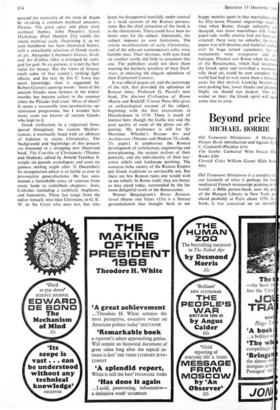Beyond price
MICHAEL BORRIE
Old Testament Miniatures: A Mediae% Picture Book introduction and legends by S C. Cockerell (Phaidon £14) The Gothic Cathedral Wim Swaan (Ele Books £10) Flemish Cities William Gaunt (Elek Book 84s) Old Testament Miniatures is a complete co our facsimile of what is perhaps the fine• mediaeval French manuscript painting in th world: a Bible picture-book, now the prod of the Morgan Library in New York, pr duced probably at Paris about 1250. As book, it was conceived on an increclibl
grandiose and costly scale. Seven artists worked on its 283 miniatures and, even so, they only got as far as the story of David. If they were originally commissioned to illustrate the complete Old Testament, one wonders who in all France could have paid for it.
It is impossible to convey in words the tremendous energy, vivid imagination, marvellous simplicity and clarity of line and colour deployed by the finest artist, who fortunately did about a third of the book. His prime purpose was undoubtedly en- tertainment rather than edification. He brings a cheerful relish to the gory sagas of Judges and Samuel which would have earned him a fortune with Hammer Films. Jael bangs her great spike into Sisera's head with a glint in her eye that Joan Crawford might envy. The Moabites are not so much sub- dued as skewered like so many kebabs. In fact, it is for its battle scenes that the book is most famous: for the successful disciplining of intense, violent activity within the narrow confines of a miniature, they have no equal in mediaeval art, and their accurate and detailed rendering of arms, armour and war- engines adds great historical interest.
The book's history is as fascinating as its contents. By about 1300 it had travelled to the south of Italy, where a text was added to the pictures. By the early seventeenth cen- tury it had found its way to Cracow, whence the archbishop, Cardinal Maciejowki, took it on a papal embassy to Persia in 1604 and presented it to Shah Abbas the Great, together with a keg of vodka and other goodies. The Shah had descriptions of the pictures written in Persian in the margins, and Hebrew translations were added still later. The Persian royal treasures were perhaps scattered when the Afghans sacked Isfahan in 1722, and the book next turns up in the hands of a Greek, who sold it at Sotheby's in 1833. The buyer was the disagreeable Sir Thomas Phillipps, whose seemingly inexhaustible library is still being dispersed at staggering prices. His heirs sold the manuscript privately to Pierpont Morgan in 1916.
The publishers have done a service in making this treasure more widely known. The edition includes Sydney Cockerell's in- troduction to the beautiful Roxburghe Club collotype facsimile of 1927, now a rare and costly collector's item.
In The Gothic Cathedral, Wim Swaan *rites interesting things about the mechanics and finance of cathedral building and the part played by mathematical and musical theory in their construction, and follows them by short, competent histories of thirty- three cathedrals illustrating the development of the Gothic style. The 400 illustrations, many of them photographs taken by the author, are often superb, with only an oc- casional fashionable nastiness, such as the photograph of the stained glass at Bourges in black and white, bled off at the bottom of the page in the middle of a roundel. And Mr Swaan is justly proud of the close-up of the magnificent but rarely reproduced 'Golden Window' of Wells, obtainable only by a hair- raising ascent to the triforium gallery.
William Gaunt's Flemish Cities are Bruges, Ghent, Brussels and Antwerp. The illustrations are routine but unexceptionable and of good quality. The whole book is a nice exercise in painless culture, a pleasant and very readable essay on the political and social conditions that produced the as- toundingly long-lied artistic apotheosis of the Low Countries, from the late Middle Ages to Van Dyck and Rubens.















































 Previous page
Previous page